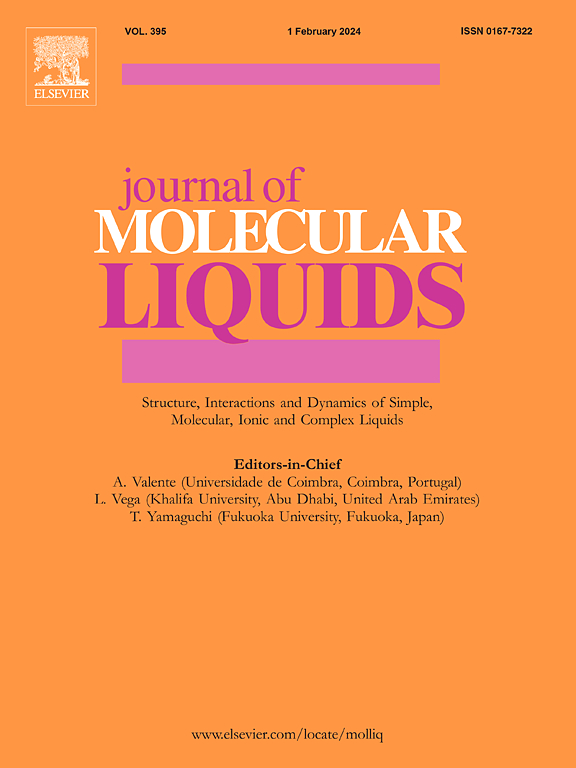Structure-activity relationship of SiO2 and ZIF-8 composite nanoparticle additives under mixed lubrication
IF 5.3
2区 化学
Q2 CHEMISTRY, PHYSICAL
引用次数: 0
Abstract
Composite additives can achieve efficient synergistic effects and improve friction performance of lubricants. The development of high-performance composite additive lubricating grease holds significant engineering value in addressing the issue of maintaining precision in precision machinery under heavy-load/confined space conditions. In this work, SiO2 and ZIF-8 mixed structures (S/Z) and core-shell structures (SiO2-core/ZIF-8-shell, S@Z) were prepared. The effect of SiO2 and ZIF-8 composite nanoparticle (NP) additives on the friction performance of lithium-based grease under mixed lubrication was explored by the experiment and molecular dynamics (MD) simulations. The results showed that the combination of SiO2 and ZIF-8 exhibited significant synergistic effects. Furthermore, S@Z was characterized by better friction performance than S/Z. Compared to the original lubricating grease, the addition of S@Z at 1.5 wt% could reduce the friction coefficient μ and wear content up to 33.74 % and 74.93 %, respectively. The MD simulation was consistent with the experimental results. The hard-core SiO2 of S@Z played a rolling and supporting role. The flexible crystal structure of the ZIF-8 shell produced significant deformation to adapt to rough surfaces. This structure avoided the rupture of the lubricating film and direct contact between the two friction surfaces, improved the bearing capacity, and prevented SiO2 from being exposed and scratching the friction surface
混合润滑条件下SiO2与ZIF-8复合纳米颗粒添加剂的构效关系
复合添加剂可以实现高效的协同作用,提高润滑油的摩擦性能。高性能复合添加剂润滑脂的开发对于解决精密机械在重载/密闭空间条件下保持精度的问题具有重要的工程价值。本文制备了SiO2- ZIF-8混合结构(S/Z)和核-壳结构(SiO2-core/ZIF-8-shell, S@Z)。通过实验和分子动力学(MD)模拟研究了SiO2和ZIF-8复合纳米颗粒(NP)添加剂对锂基润滑脂混合润滑摩擦性能的影响。结果表明,SiO2与ZIF-8的结合表现出显著的协同效应。此外,S@Z的摩擦性能优于S/Z。与原润滑油脂相比,添加量为1.5 wt%的S@Z可使摩擦系数μ降低33.74%,磨损量降低74.93%。MD模拟与实验结果吻合较好。S@Z的硬核SiO2起到了滚动和支撑作用。ZIF-8外壳的柔性晶体结构产生了显著的变形,以适应粗糙的表面。这种结构避免了润滑膜的破裂和两个摩擦面之间的直接接触,提高了承载能力,并防止了SiO2暴露和划伤摩擦面
本文章由计算机程序翻译,如有差异,请以英文原文为准。
求助全文
约1分钟内获得全文
求助全文
来源期刊

Journal of Molecular Liquids
化学-物理:原子、分子和化学物理
CiteScore
10.30
自引率
16.70%
发文量
2597
审稿时长
78 days
期刊介绍:
The journal includes papers in the following areas:
– Simple organic liquids and mixtures
– Ionic liquids
– Surfactant solutions (including micelles and vesicles) and liquid interfaces
– Colloidal solutions and nanoparticles
– Thermotropic and lyotropic liquid crystals
– Ferrofluids
– Water, aqueous solutions and other hydrogen-bonded liquids
– Lubricants, polymer solutions and melts
– Molten metals and salts
– Phase transitions and critical phenomena in liquids and confined fluids
– Self assembly in complex liquids.– Biomolecules in solution
The emphasis is on the molecular (or microscopic) understanding of particular liquids or liquid systems, especially concerning structure, dynamics and intermolecular forces. The experimental techniques used may include:
– Conventional spectroscopy (mid-IR and far-IR, Raman, NMR, etc.)
– Non-linear optics and time resolved spectroscopy (psec, fsec, asec, ISRS, etc.)
– Light scattering (Rayleigh, Brillouin, PCS, etc.)
– Dielectric relaxation
– X-ray and neutron scattering and diffraction.
Experimental studies, computer simulations (MD or MC) and analytical theory will be considered for publication; papers just reporting experimental results that do not contribute to the understanding of the fundamentals of molecular and ionic liquids will not be accepted. Only papers of a non-routine nature and advancing the field will be considered for publication.
 求助内容:
求助内容: 应助结果提醒方式:
应助结果提醒方式:


